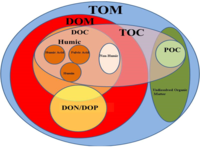
Photo from wikipedia
Abstract It has been well acknowledged that a continuous increase in atmospheric carbon dioxide (CO2) concentration will lead to climate warming. Numerous experiments have found that increased precipitation could promote… Click to show full abstract
Abstract It has been well acknowledged that a continuous increase in atmospheric carbon dioxide (CO2) concentration will lead to climate warming. Numerous experiments have found that increased precipitation could promote soil CO2 emissions into the atmosphere, but there is great uncertainty in the magnitude of increased precipitation of this feedback. Here, we assessed the influences of different durations and magnitudes of increased precipitation on soil CO2 efflux across biomes through a meta-analysis. Humid (extremely wet, moderately wet, and slightly wet), temperate, and arid (slight drought, moderate drought and extreme drought) areas were classified according to the Palmer drought severity index (PDSI). Overall, the average experimentally applied precipitation increases of 31.81%, 19.14% and 37.68% significantly stimulated soil CO2 efflux by 12.74%, 13.10% and 14.71%, respectively for experiments from all areas, humid areas, and arid areas. No significant effects were found for temperate areas. Increased precipitation stimulated large soil CO2 efflux in extreme drought areas (PDSI > −3) by 38.09%. Moreover, soil CO2 efflux increased with increasing precipitation intensity but decreased with increasing precipitation duration regardless of the area with different PDSIs. Our results highlight the positive feedback between soil CO2 efflux and increased precipitation in both humid and arid terrestrial ecosystems, which improves our understanding in possible climate change effects on the global carbon cycle. Further efforts should assess the differential effects of various durations and magnitudes of increased precipitation in ecosystems with different wetness conditions.
Journal Title: Geoderma
Year Published: 2021
Link to full text (if available)
Share on Social Media: Sign Up to like & get
recommendations!